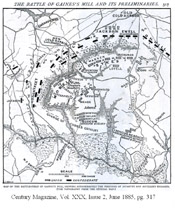
The Battle of Gains' Mill
click on image for larger view
Due to reports of the advancement of all of Jacksonís force on the Unionís
unprotected
flank, Union forces started to withdraw from the Mechanicsville
area early in the morning. The
Fourth US, after returning to camp from the
prior nights bivouac collected their knapsacks, sent the
sick across the
Chickahominy, and destroyed commissary and other stores (keeping cigars
taken from the
sutlerís store). The First brigade crossed the Chickahominy
at Gainsí Mill and took up new positions.
The First Brigade was on the
extreme right of the Union forces with the Fourth US at the extreme right
of
the brigadeís position. The Fourth US was placed specifically in support of
Weedís artillery battery
which commanded the approach from Old Cold
Harbor. The Second division was originally positioned near
New Cold Harbor,
but was later moved to a second position at Dispatch Station on the
Richmond and New
York River Railroad. The Third was along the road and
the Twelfth and Fourteenth regiments were in
positions in a corn field. The
brigade of General Seymour was the rear guard. While the position was a
strong one, being on the crest of a hill with partial cover from fences, there
was thick timber
about 400 yards to the front which masked Confederate movements.
The position occupied by the Fourth US was heavily attacked by Confederate artillery
between 11 a.m. and
noon. The position was reinforced by a battery of horse artillery, commanded by
Tidball in the early afternoon.
Confederate artillery fire continued, with some breaks until dark. The
Confederate troops under D. H. Hill (part
of Thomas Jacksonís Corps) launched three attacks against
the batteries protected by the Fourth but, in all
cases were repulsed. At dusk, the batteries, nearly
out of ammunition, retired (in his report on the battle,
Captain Weed reports having fired something over
1,000 rounds). Captain Collins, having taken command with
the absence of Major D. Davidson, placed
(under fire) the Regiment, by a flank movement, at the double time,
along a split rail fence between
the batteries and the Confederate forces, allowing the batteries to retire in
good order. He later
followed, also in good order. The Regiment and the batteries bivouacked on the north side
(enemy side)
of the Chickahominy, having no orders to cross the river (three messengers, bearing messages
to
retire across the river having failed to reach the Regiment). This position covered Grapevine Bridge.
The
fierce defense put up by the Fourth US and the two batteries prevented the Confederate forces from
turning the
right flank of the Union forces.
Captain Collins retained command of the regiment through the remainder of the seven days fight.
On the morning of the 28th, with the grapevine bridge having been partially
destroyed, the regiment at first
started an advance to a point near their prior daysí position but finding
that they were the only Union force north
of the river, retired, marched to Alexanderís Bridge and crossed
the Chickahominy River at that point Ė the last
regiment to do so.
The brunt of the fighting at Gaines Mill was done by General Porterís Fifth Army
Corps (1 of 5 Corps in the Army
of the Potomac), the remainder of the Army of the Potomac was in defensive
positions south of the Chickahominy.
Against the Fifth Corps, with almost a two to one numerical advantage,
were the combined Confederate troops
under Generals Robert E. Lee, James Longstreet, Thomas Jackson,
D. H. Hill, and A. P. Hill. Their battle reports
sustained the belief that they had encountered the main
body of the Union Army.